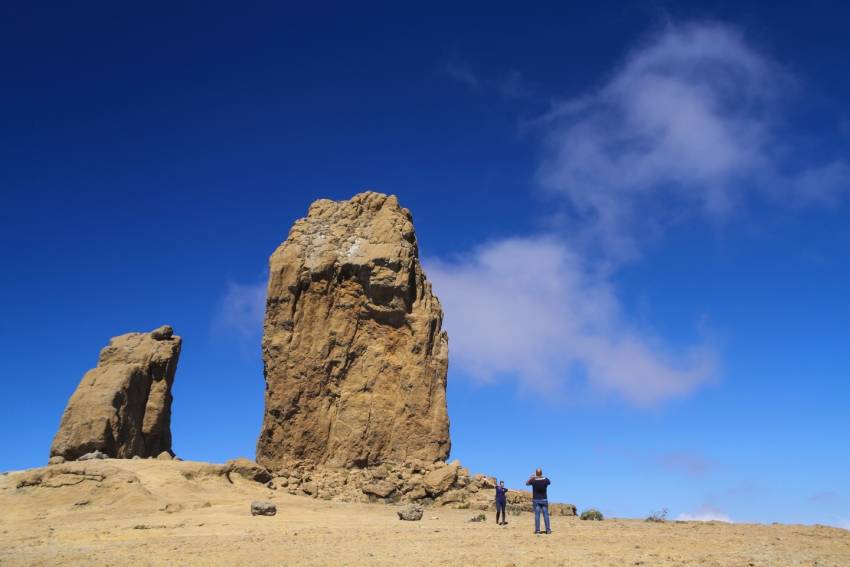Iconic Gran Canaria: The Bits You Have To See
Once you start getting to know Gran Canaria you find beautiful spots all over the place. But if you only have a week to see Gran Canaria and want to spend some time sunbathing, here's our guide to the island's must-see iconic spots.
Whitewash, Fish And Pebbles At Puerto De Las Nieves
Puerto de Las Nieves is the prettiest coastal village in Gran Canaria and while its iconic rock lost its finger in 2005 the village still has its fishy charm. The houses are all whitewashed, the window frames blue, and the beachfront restaurants serve local fish.
And it's sunny: The area has its own microclimate and gets almost as much sunshine as the southern resorts. Even when the whole of the north coast is cloudy, Puerto de las Nieves and Agaete get blue skies.
Things to do and see
Other than eat, swim and relax there's not much (and that's why we love it):
With the locals cramming in at the weekends for a weekend seafood feast, it's best to visit during the week when things are calmer.
Puerto de Las Nieves’ iconic Dedo de Dios (Finger of God) rock sadly lost its finger during a storm a few years ago. You can see the knuckle by looking left from the end of the jetty.
The natural swimming pools, with lava arches and plenty of space to sunbathe, are a great sunset spot.
The famous set of Dutch paintings that give the town its name are in the church, but it's permanently locked.
Most restaurants close in the evening and the nearest bars are in Agaete just inland.
The Agaete Valley behind the town is one of the prettiest in Gran Canaria and is full of traditional houses, palm trees and coffee. The road up ends at the top so you have to drive back the way you came.
Adventurous drivers head from Agaete along the west coast on the spectacular, cliff-edge road to La Aldea de San Nicolas. It’s windy and the drop offs extreme. For those with vertigo, it’s a no-no.
There're several natural, nudist beaches within walking distance.
Beaches
From the town walk up the hill to Turman (a housing estate on the little hill behind the town). Here, a dirt path runs to La Caleta Bay with its pebble beach and rock shelves. There's a set of convenient steps running down to La Caleta. It takes ten minutes to walk from the town up to Turman, and another 15 to get to La Caleta.
El Juncal is another 40 minutes walk past Caleta: It’s a pretty valley with a bigger pebble beach at its mouth. Juncal is clothing optional and often empty as the only way in is on foot or with a four-wheel drive. The walk is pretty dusty, but you get some great views of the coast and the spectacular west coast cliffs. Take food and water as there are no facilities at all at El Juncal. The water is crystal clear and the snorkelling is excellent.
Further away, to the south, is Guayedra Beach: A firm favourite for locals and people from the nearby town of Galdar. The walk from Puerto de Las Nieves has some steep drop-offs and takes about an hour-and-a-half. The beach is mixed sand and pebbles (no facilities) and mostly nudist.
Food
Most restaurants have outdoor terraces with views of the beaches. Until recently they all did seafood stapes like fried fish, calamares, sardines, etc. Now there's a couple of Italian options as well.
Always ask for an ensalada mixta as the Puerto de Las Nieves version always comes with tropical fruit along with the standard Canarian salad ingredients (lettuce, tomato, cucumber, red onion, tuna, asparagus, corn, etc). Order a salad for half the number of people at the table.
The Las Nasas restaurant is the most famous restaurant in town because of its lovely terrace. Arrive at 13.00 at weekends for a guaranteed terrace table. A
The Dedo de Dios restaurant (left of the stone jetty) doesn’t have outside terrace space but is cheap and does huge portions of very reasonable food. It even opens at night.
Gran Canaria Info recommends:
- Default
- Title
- Date
- Random














